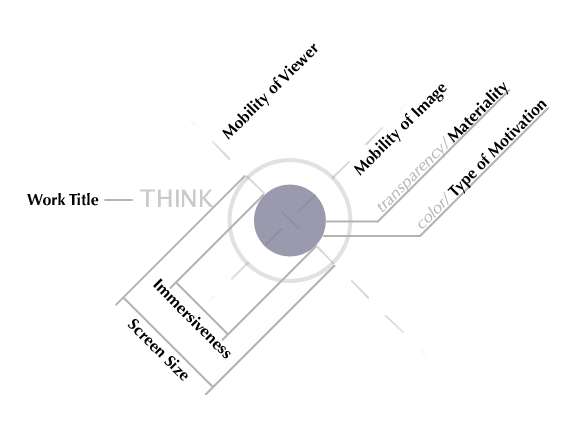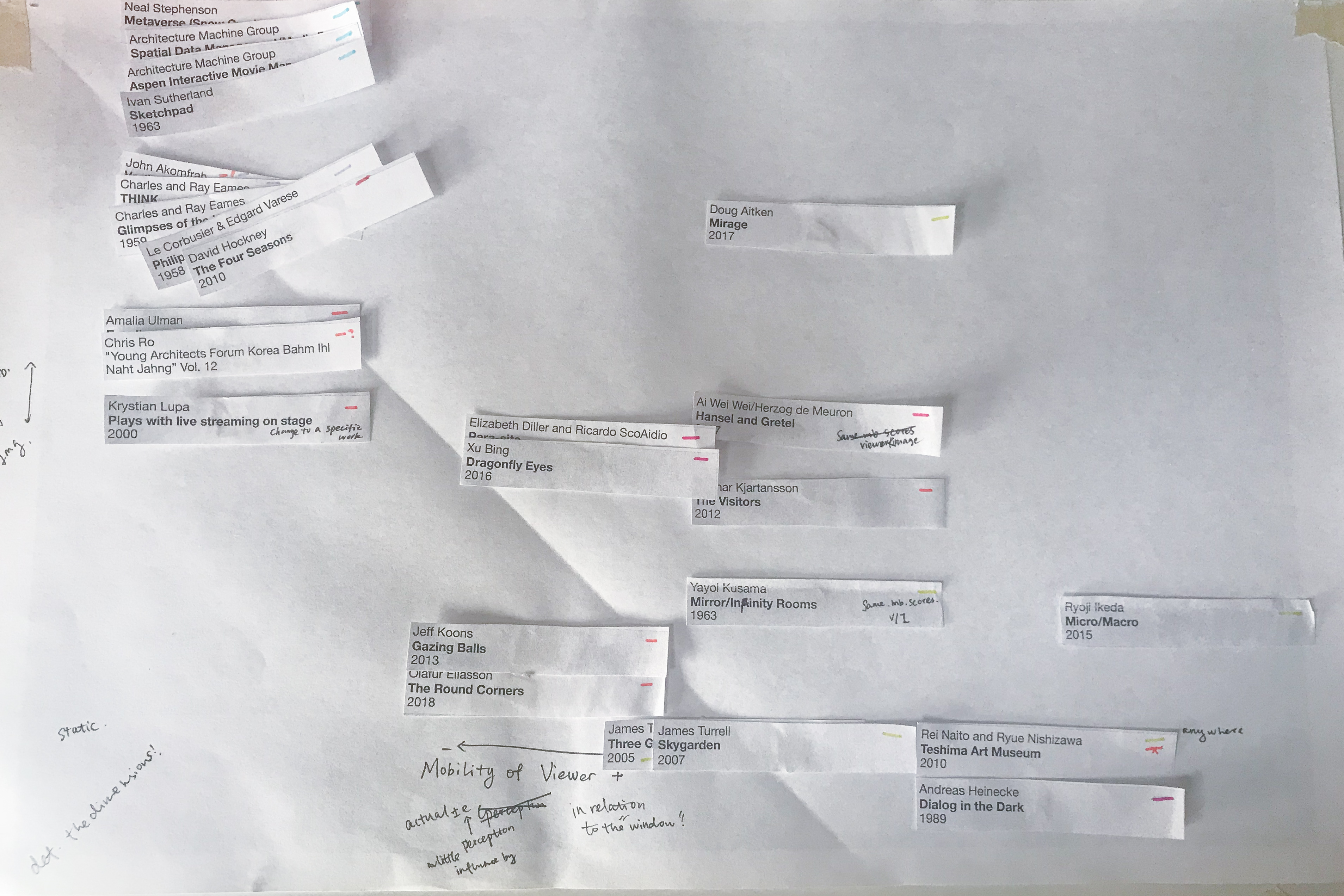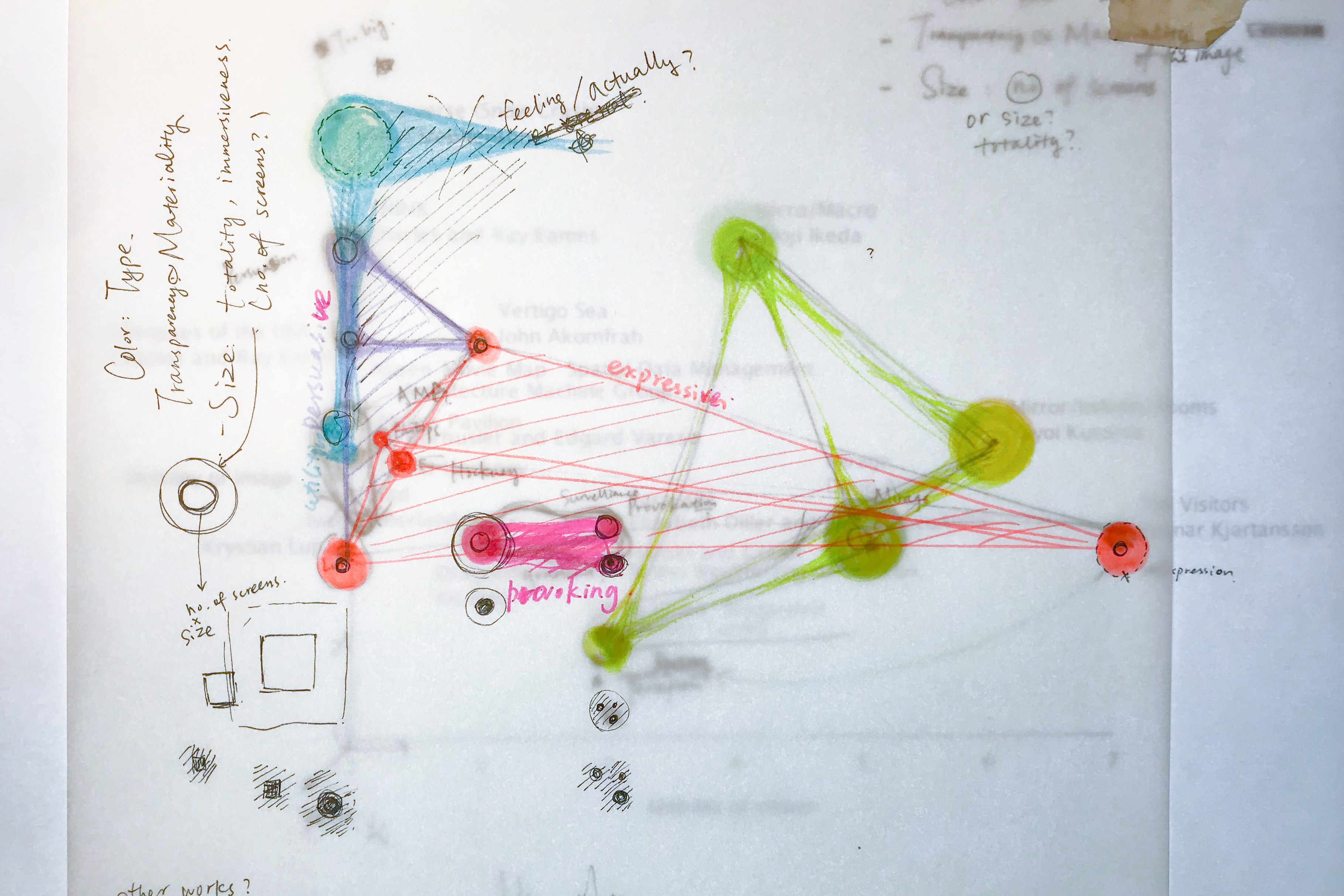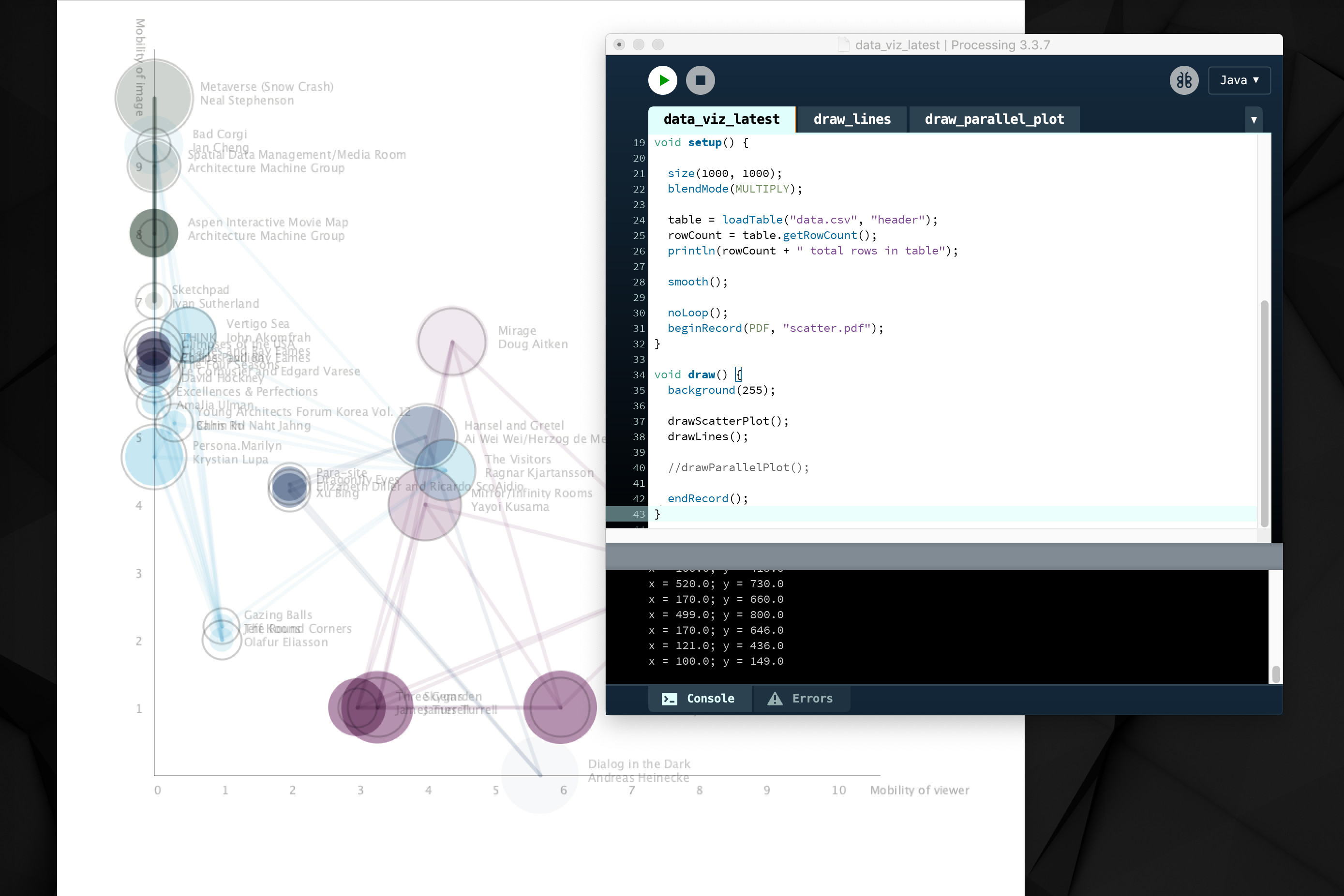Virtual Windows
A map of the relationships among images, spectators, and space, in examples of "virtual windows" from contemporary art, design, architecture, and performing art.
#DataVisulization, #MediaTheory
Dec 2018 / Course: Context: Space/Screen / Instructor: Randy Rakamura
Credit
The pool of works is a combination of projects for discussion in the "Space/Screen" course) and other works engaged the idea of a "virtual window." The primary reference for the analysis (Anne Friedberg's The Virtual Window) was also a reading material for the class.

Introduction
Back since Leon Battista Alberti wrote the 1435 treatise, De pictura, on image and perspective, “window” has long been the popular metaphor to describe frames and screens we look at, and to analyze all kinds of images they contain (paintings, photographs, videos, etc.). Ubiquitous windows, frames, and screens bring images under a magnifier. To understand our visual culture, how the world is framed also becomes important.
In The Virtual Window, Anne Friedberg (2006) borrows this lens to examine how the screens we are staring at everyday work as the aperture in a space that frame dematerialized reality. Inspired by Friedberg’s theoretical framework, this map inspects 26 works with screens, windows, mirrors, or other features alike from the realm of contemporary art, design, architecture, and performing art.
The map positions the works by how they are perceived to be—physical or virtual, still or moving, objectified or ambient—and classifying them by the motive of creation. Specifically, It regards the size, materiality, and mobility of images, the mobility of viewers, and how immersive the screen-space ensembles are. It also shows differences between works by the intent, and consistency and variation within.

Detailed relationships among screen size, immersiveness, and materiality of image. One work usually has similar screen size and immersiveness, with one exception where there is no visual at all yet being the most immersive (Dialog in the Dark). There is no clear relation between how materialized the image is and how much space it occupies or how immersive it feels.
Method & Process
Selecting the Works
All listed works are related to the idea of a virtual window.* Regardless of their small number, the selected works cover a wide range of visual media:
- building, sculpture, installation, theatrical production
- TV, computer, phone
- VR, projection
and domains:
- art
- design
- architecture
- software
- performing arts
And each is unique among the selection and important of its kind.
* Things that are framed by screens, mirrors, subsistent apertures on walls, etc.. The majority and the foundation the works are a subset of projects in the "Space/Screen" course syllabus. Additional works also engaged the idea were supplemented, which are either pioneers of their forms or by popular artists today.
WORKS INDEX
Utilitarian
• Ivan Sutherland, Sketchpad, 1963.
• Architecture Machine Group, Spatial Data Management/Media Room, 1977.
• Architecture Machine Group, Aspen Movie Map, 1981.
• Neal Stephenson, “Metaverse” (in Snow Crash), 1992.
Expressive
• Krystian Lupa, Persona.Marilyn, 2009. *
• David Hockney, The Four Seasons, 2010. *
• Ragnar Kjartansson, The Visitors, 2012.
• Jeff Koons, Gazing Balls, 2013. *
• John Akomfrah, Vertigo Sea, 2015.
• Ian Cheng, Bad Corgi, 2016.
• Olafur Eliasson, The Round Corners, 2018. *
• Chris Ro, Young Architects Forum Korea Vol. 12 Bahm Ihl Naht Jahng. *
Provocative
• Andreas Heinecke, Dialog in the Dark, 1989. *
• Elizabeth Diller and Ricardo ScoAidio, Para-site, 1989.
• Amalia Ulman, Excellences & Perfections, 2014. *
• Xu Bing, Dragonfly Eyes, 2016.
• Ai Wei Wei and Herzog & de Meuron, Hansel and Gretel, 2017.
Persuasive
• Charles and Ray Eames, Glimpses of the USA, 1959.
• Charles and Ray Eames, THINK, 1964.
• Le Corbusier and Edgard Varese, Philips Pavilion (Poème électronique), 1958.
Ambient
• Yayoi Kusama, Infinity Mirror Room—Phalli’s Field, 1965.
• James Turrell, Three Gems, 2005.
• James Turrell, Skygarden, 2007.
• Rei Naito and Ryue Nishizawa, Teshima Art Museum, 2010. *
• Ryoji Ikeda, Micro/Macro, 2015.
• Doug Aitken, Mirage, 2017.
Ambient
• Yayoi Kusama, Infinity Mirror Room—Phalli’s Field, 1965.
• James Turrell, Three Gems, 2005.
• James Turrell, Skygarden, 2007.
• Rei Naito and Ryue Nishizawa, Teshima Art Museum, 2010. *
• Ryoji Ikeda, Micro/Macro, 2015.
• Doug Aitken, Mirage, 2017.

Factors for Analysis
According to Friedberg, the prominent function of screens is to enable immobile viewers to see mobile, dematerialized images—thus we have the three dominant traits to differentiate the works:
- Mobility of the viewer: measures their mobility relative to the screen
- Mobility of the image: reflects the range of visual changes.
- Materiality: Is the image physical or virtual? If virtual, is it live, recorded, or purely abstract?
Another two correlative factors are:
- Screen size: a window is to architecture what a screen is to the physical space it occupies. The 26 works take up various space due to their different media.
- Immersiveness: how much they draw the audience from the regular world to the physical or virtual space they reside.
Finally, the categorical factor:
- Motivation: the intention to create the works also influence how they are distributed on the map. Although one work may fall in more than one categories, only the most dominant type is selected as its tag.
Rating & Mapping
The values of each variable above (except for motivation) are found by firstly determining examples or descriptions of the minimum and maximum level, which are marked as 0 and 10; then putting all the works on the 0-to-10 scale. The values are the reflection of my personal understanding and impression.

Define the relative ranking of works on each measurement, in order to rate them.

Initial sketching on paper, where I roughly mapped the works and explored the visual language.

Use Processing to convert numbers into a vector image, before final editing.